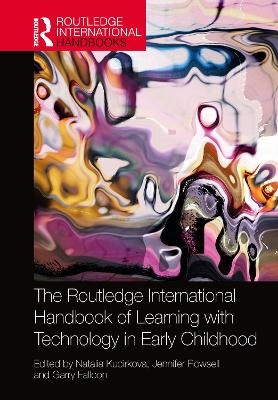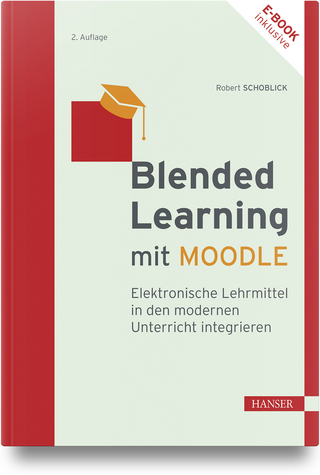
The Routledge International Handbook of Learning with Technology in Early Childhood
Routledge (Verlag)
978-1-138-30819-0 (ISBN)
Natalia Kucirkova is Senior Research Fellow at University College London, UK. She graduated in Psychology, holds a Masters in Research Methods and a Doctorate in Education. She worked at the Oxford University Education Department, pursued a pre-doctoral fellowship at the Harvard Graduate School of Education and currently works as Senior Research Fellow at University College London, UK. Her research concerns innovative ways of supporting children’s book reading, digital literacy and exploring the role of personalisation in early years. Her publications appeared in Communication Disorders Quarterly, First Language, Computers & Education or Cambridge Journal of Education. She has been commended for her engagement with teachers and parents at a national and international level. Jennifer Roswell is Professor in the department of Teacher Education and Canada Research Chair in Multiliteracies at Brock University, Canada. Her research interests include: research in schools and communities doing multimodal work with children and youth; exploring how younger generations think and interact through technologies, videogames and immersive environments; and, longitudinal work in homes connecting artifacts and material worlds with literacy and identity practices. She is Co-Series Editor with Cynthia Lewis of the Routledge Expanding Literacies in Education Series and the Digital Literacy Editor for The Reading Teacher. Her latest books are The Routledge Handbook of Literacy Studies, co-edited with Kate Pahl and Generation Z: Zombies, Popular Culture, and Educating Youth, Co-Edited with Victoria Carrington, Esther Priyadharshini, and Rebecca Westrup.
Foreword
Rosie Flewitt (University College of London, UK)
Section One: Studying children’s contemporary play
Cut it out! Materiality and Action in Children’s Play and Toymaking
Karen Wohlwend & Jaye Johnson Thiel Indiana University, USA
Chestcam tales: Exploring embodied ethnography with young children
Jackie Marsh, University of Sheffield, UK
The development of childhood cultures
Anne Haas Dyson, Illinois University, USA
Section Two: Studying specific groups of children
Meeting the needs of students in a multilingual classroom: Linking Research to Practice
Rahat Zaidi, University of Calgary, Canada
Research with children with SEN
Melissa Allen, Lancaster University, UK
Children from diverse backgrounds
Jim Anderson, British Columbia
Section Three: Studying children’s practices at home and in lab settings
Learning at home
Laidlaw, O’Mara & Wong, Deakin University, Australia
Community-based research
Pam Whitty, University of New Brunswick, Canada
Using magnetic resonance imaging in infants and young children and its implication for bridging the fields of Neuroscience and Education
Nadine Gaab, Harvard University, USA
Section Four: Children’s global practices and movement through space
"Talk into my GoPro, I’m making a movie!" Using digital ethnographic methods to explore children’s experiences in the woods
Debra Harwood & Diane Collier, Brock University, Canada
Deep hanging out: artifactual literacies and ethnographic methods
Margaret Somerville & Sarah Powell, Western Sydney University, Australia
Getting away from the screen: the play affordances of Internet connected toys
Donell Holloway, Edith Cowan University, Australia
Section Five: Studying children’s learning with others
This is the stuff that literacies are made of: Researching children’s learning with grandparents and other elders through ethnographic methods
Rachel Heydon, & Xiaoxiao Du, University of Western Ontario, Canada
Children and parents interacting together with an app support
Kathy Sylva & Fiona Roberts, University of Oxford, UK
Children learning in their families
Tisha Lewis, University of Georgia, USA
Section Six: Children’s learning through body, embodiment and haptics
Embodiment
Kerryn Dixon, Wits University, South Africa
Technologies, affordances, children and (embodied) reading: a call for intedisciplinarity
Anne Mangen, Trude Hoel, Thomas Moser, University of Oslo, Norway
Valuing Signs of Learning: A Multimodal Perspective on Observation and Digital Documentation in Early Years Classrooms
Kate Cowan, University College London, UK
Section Seven: Studying reading and interacting on screen
Eye-tracking and e-books
Zsofia Takacs, Eötvös Loránd University, Hungray
Lab-based studies of children’s reading on screen
Brenna Hassinger and Rebecca Dore, University of Delaware, USA
Visual methods for studying children’s interactions on screen
Abi Hackett & Lucy Caton, Manchester Metorpolitan University, UK
Section Eight: Children’s multiliteracies
Who's helping who?: Young children seeking help when learning to write
Annette Woods, Queensland University of Technology, Australia
Children’s literature and critical literacy
Peggy Albers, Georgia State University, USA, together with Vivian Vasquez and Jerry Harste
Methodologies without methodology: (Re)imagining research practices when thinking with poststructural and posthumanist theories
Candace Kuby, Missouri University, USA
Section Nine: Children’s drawing, mark-making and arts
Studying science apps in low-income pre-schools
Lena Lee, Miami University, USA
Storying as a methodology in early years classrooms
Cathy Burnett and Guy Merchant, Sheffield Hallam University, UK
Student generated visual narratives: lived experiences of learning
Narelle Lemon, La Trobe University, Australia
Arts-based methods
Linda Knight, Queensland University of Technology, Australia
| Erscheinungsdatum | 21.03.2020 |
|---|---|
| Reihe/Serie | Routledge International Handbooks of Education |
| Verlagsort | London |
| Sprache | englisch |
| Maße | 174 x 246 mm |
| Gewicht | 453 g |
| Themenwelt | Schulbuch / Wörterbuch ► Unterrichtsvorbereitung ► Unterrichts-Handreichungen |
| Sozialwissenschaften ► Pädagogik ► Vorschulpädagogik | |
| ISBN-10 | 1-138-30819-6 / 1138308196 |
| ISBN-13 | 978-1-138-30819-0 / 9781138308190 |
| Zustand | Neuware |
| Haben Sie eine Frage zum Produkt? |
aus dem Bereich


